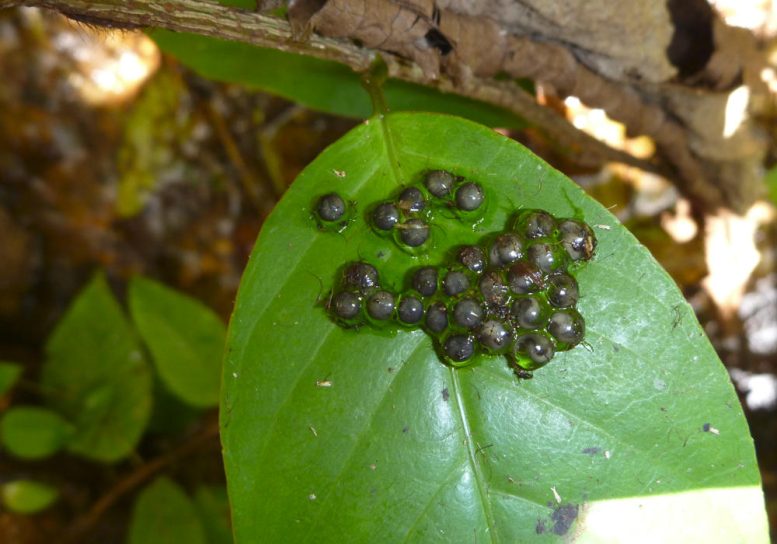A new study has identified the smallest canine frogs in Southeast Asia that have unique traits such as terrestrial egg-laying and male egg guarding. This discovery in Sulawesi, Indonesia contributes to our understanding of amphibian diversity and underscores the need to protect these unique ecosystems. Above is a photo of a new species of frog, Limnonectes phyllofolia. Credit: Sean Reilly
The males of these small frogs guard the eggs that are laid on the leaves.
In general, frogs' teeth are not special – they appear as small, sharp spikes on the upper jaw. However, a group of frogs that live in streams in Southeast Asia have a strange adaptation: two bony „teeth” protruding from their lower jaws. They use these teeth to fight each other over territory and mates, and sometimes to hunt hard-shelled prey such as giant centipedes and crabs. A new study, published in the journal PLOS ONEResearchers have described a new species Canine Frog: Smallest ever discovered.
„This new species is about one-fourth the size of other canine frogs found on the island,” said Jeff Frederick, a postdoctoral researcher at the Field Museum in Chicago and lead author of the study. As a Ph.D University of California, Berkeley. „Many frogs in this species weigh up to two pounds. At the larger end, this new species weighs about a dime.
Unique habitat of Sulawesi
In collaboration with the Bogor Zoological Museum, a team from the McGuire Laboratory at Berkeley found the frogs in Sulawesi, a rugged, mountainous island that is part of Indonesia. „It's a giant island with a vast network of mountains, volcanoes, lowland rainforests and mountain cloud forests. With all these different habitats, the amount of biodiversity in many plants and animals is unreal – rivaling places like the Amazon,” says Frederick.
While hiking through the forest, members of the US-Indonesia Amphibian and Reptile Research Team noticed something unexpected among tree sapling leaves and moss-covered boulders: nests of frog eggs.

A new variety of frog eggs, laid on a leaf. Credit: Sean Reilly
Frogs are amphibians, and they lay eggs covered in jelly rather than a hard, protective shell. To keep their eggs from drying out, most amphibians lay their eggs in water. To the research team's surprise, they continued to find terrestrial eggs in leaves and mossy rocks several feet above the ground. After a while, they started seeing small, brown frogs.
„Usually when we're looking for frogs, we scan the edges of stream banks or wade through streams to find them directly in the water,” Frederick says. „After repeated monitoring of nests, the team began to find frogs sitting on leaves and hugging their tiny nests.” This close contact with their eggs allows the frog parents to coat the eggs with compounds that keep them moist and free from bacterial and fungal contamination.
Link between reproductive behavior and fang size
A closer examination of the amphibian parents revealed that they are the smallest members of the canine frog family, and not only do they have barely visible fangs, but the frogs tending to the clutches of eggs are all male. „Male egg-guarding behavior is not completely unknown in all frogs, but it is very unusual,” says Frederick.
Frederick and his colleagues hypothesize that the frogs' unusual reproductive behaviors may be related to their smaller-than-usual teeth. Some frog relatives have large fangs that help them fend off competition for spots on river banks where they spawn in the water. As these frogs evolved to lay their eggs out of water, they may have lost the need for such large fangs. (The scientific name of the new species Limnonectes phyllofolia; Phylofolia means „leaf gatherer”.)
„It's fascinating that with each subsequent trip to Sulawesi, we're still finding new and different breeding methods,” says Frederick. „Our findings also underscore the importance of protecting these special tropical habitats. Most of the animals that live in places like Sulawesi are very unique, and habitat destruction is an ever-growing conservation issue to protect the hyper-diversity of species we find there. Learning about animals like these frogs, which are found nowhere else on Earth, is Helps build the case for protecting valuable ecosystems.
Note: Jeffrey H. Frederick, Joko D. Iskandar, Aval Ryanto, Amir Hamidi, Sean B. Reilly, Alexander L. Stubbs, „A new species of ground-nesting canine frog (Anura: Dicroglossidae) from the island of Sulawesi, Indonesia,” Luke M. Bloch, Bryan Bach, and Jimmy A. McGuire, 20 Dec. 2023, PLOS ONE.
DOI: 10.1371/journal.pone.0292598

„Oddany rozwiązywacz problemów. Przyjazny hipsterom praktykant bekonu. Miłośnik kawy. Nieuleczalny introwertyk. Student.
